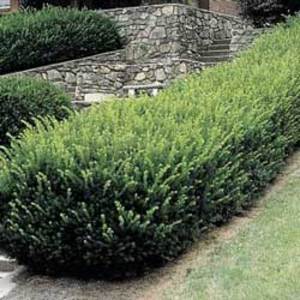Japanese Yews are very commonly used in zones 4 however many people do not know they are perfect for zones 4-7. They are a woody perennial that came over from Japan, China and/or Korea that are notably perfect for tall hedges for privacy. Are you aware though that they are dangerously toxic to animals? In addition, for smaller children the berries could be very dangerous and cause illness and sometimes death.
The Japanese Yew is part of the Genus Taxus and is the T. cuspidate species. They are needle-bearing evergreens. Its evergreen leaves are flat ½ to 1 inch long that is lighter green on the underside and broader than pine needles. The “aril” (or better known as the berry) is bright red and can grow to the size of a grape. The aril has a hole in the center which makes it look like a cup or bead. Japanese yews are noted to be dioecious, which basically means that each plant either holds female or male organs. It is much like humans reproductive systems. Therefore the arils are only seen when a male bush and a female bush are set next to each other in the yard.
Although there are many yews, the Japanese yew is most famous for its large growth potential. Each bush can reach to around thirty feet tall and eight to ten feet wide. Do not be afraid to use them as a small hedge though since they are very receptive to pruning, not severe pruning though. In addition, they are very slow growing; therefore it is not hard to keep up with the pruning to minimize the growth against its full potential.
Planting the bush is very easy, much like other plants. Within one week of purchasing the new Japanese Yew, planting should take place in the yard. Taking into consideration of Japanese Yew that you have purchased, use a mild fertilizer to mix in with the ground soil about one foot into the ground. This will allow the Japanese Yew to get off on a good start. Then, dig a hole in that same area about one foot larger than the size of the roots. Remember to slightly elevate the bush from the ground, never plant at the normal ground level since proper drainage will not be received. Cover with the left over soil from the hole and with a thin layer of mulch. Give the area a good watering and the bush is all set. Light watering is needed during droughts however daily watering is unnecessary. Depending on your usage of the bush, light pruning may be required. Immediately remove the clippings though, do not through them in a compost or leave the clippings on the ground.
It is important to note that this bush is very toxic and will kill wild animals, birds and on rare occasion pets. There have been some cases reported where children have eaten the berries and gotten sick also. This plant should never be planted in a location that the animals are at threat. If you do have a Japanese Yew in your area, try to keep all the animals and children away from the bush. Naturally, dogs and cats are smart enough not to touch the bush. On the other hand, horses, cattle, sheep, goats, pigs, birds are more than likely to eat the bush berries. Within five minutes of eating the berries, the animal will die. There are no cures since the berries cause cardiac and/or respiratory collapse almost instantly. If the animal is still alive after eating, contact a veterinarian immediately. Some rare accounts have been reported that dogs have eaten the berries and have signs of gastroenteritis, seizures, and aggressive behavior which can be dangerous to the owner.
So, although this bush is toxic, it is usually fine to have as an ornamental bush in the yard. They are historically noted for the berries during the winter seasons, which add a little color in the snowy states. They can be planted in full sun or shady locations; therefore they are very adaptable to any garden and should be considered.





